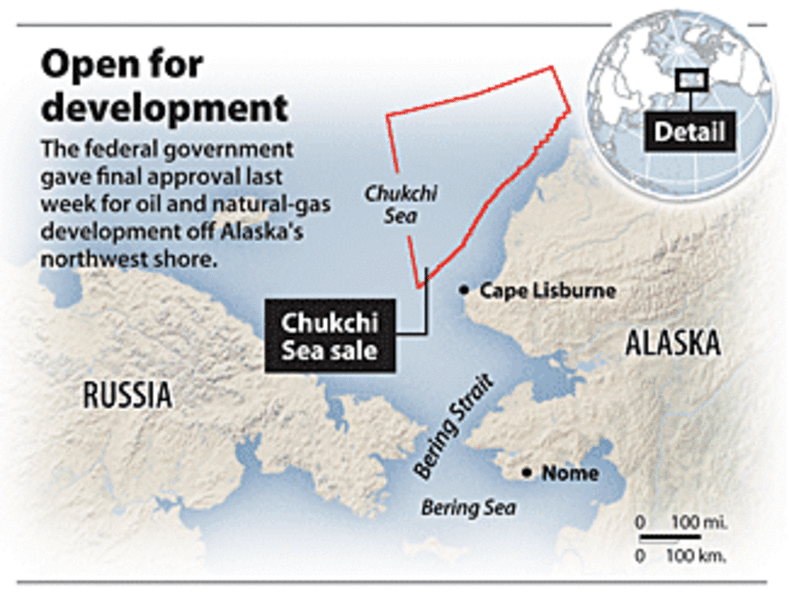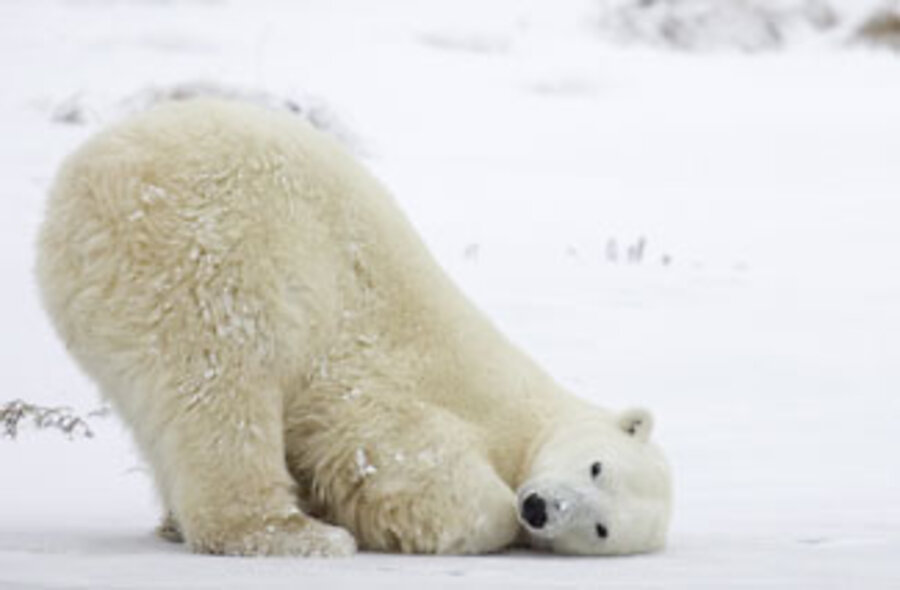Climate worries complicate Alaska drilling plan
Loading...
A controversial proposal to extract vast supplies of oil and gas from Alaska's outer continental shelf pits America's energy needs against environmental protection. Unlike similar clashes in the past, there's a complicating factor this time: global warming.
The US Interior Department's Minerals Management Service (MMS) is offering the sale of oil and gas leases covering nearly 46,000 square miles in the Chukchi Sea off the northwest coast of Alaska.
Initial geological studies indicate that the area, roughly the size of Pennsylvania, has the potential to produce 15 billion barrels of recoverable oil and 77 trillion cubic feet of natural gas. Together with the potential energy development from lease sales offered recently in the nearby Beaufort Sea, that's enough to fuel 25 million cars and heat 46 million homes for 30 years.
"It's a significant slice of the energy we consume, based upon current rates," says Richard Ranger, an adviser with the American Petroleum Institute, an industry group. "The potential, we would argue, is of strategic significance."
The proposal comes at a time when moratoriums on new leases, as well as restrictions on exploration in the Arctic National Wildlife Refuge and two areas of the outer continental shelf in the Atlantic and Pacific, "have had the effect of really limiting where we can look for energy Americans need," says Mr. Ranger.
At the same time, with new exploration and drilling technologies, the odds of success are becoming more favorable.
The Gulf of Mexico, for example, is generally seen as a mature site for oil. But recent advances allowing offshore rigs to drill deeper has led to discoveries since the mid-1990s that have essentially yielded the equivalent of the amount imported from Saudi Arabia, says Ranger. Natural-gas production there has increased fourfold over the same period.
In the Rocky Mountain states – New Mexico, Colorado, Utah, Wyoming, and Montana – the ability to extract natural gas from coal seams and other technological advances mean the region now produces 20 to 25 percent of the nation's gas. That figure could increase to as much as 40 percent by the 2020s.
Until further explorations are made, nobody knows for sure whether the Chukchi lease sale will be equally as productive.
In any case, there's a complicating factor: The lease sale comes as Arctic sea ice has been dwindling at record rates, probably tied to warming caused by climate change. In September, US Geological Survey (USGS) scientists warned that "projected changes in future sea ice conditions, if realized, will result in loss of approximately two-thirds of the world's current polar bear population by the mid 21st century."
"Because the observed trajectory of Arctic sea ice decline appears to be underestimated by currently available models, this assessment of future polar bear status may be conservative," USGS reported.
All the more reason not to further interfere with polar habitat, environmentalists say, since the bears rely on sea ice for hunting and denning. "The chances for the continued survival of this icon of the Arctic will be greatly diminished if its remaining critical habitat is turned into a vast oil and gas field," says Margaret Williams, managing director of the World Wildlife Fund's Kamchatka and Bering Sea program.
Critics note that the federal government is considering whether to list the polar bear as "threatened" under the Endangered Species Act. Such a listing would require the US Fish and Wildlife Service to designate critical habitat for the bears, which could include parts of the Chukchi Sea.
But it's not just polar bears. Walruses are threatened by shrinking ice as well. Bowhead and beluga whales migrate through the Chukchi Sea, and several shorebird species (some of them endangered) breed in the Chukchi's estuaries and bays.
In the Beaufort Sea, oil company Shell has been temporarily blocked from drilling exploratory wells on the leases it purchased. A federal lawsuit contends that migrating bowhead whales – important to native subsistence hunters – would be harmed by oil and gas operations.
Government officials say they take seriously the need to protect wildlife that could be affected by the search for fossil fuels. Among other things, near-shore waters as far out as 50 miles are not included in the Chukchi oil and gas lease sale. This is to protect bowhead and beluga whales, other marine mammals, and migrating birds. The sale also stipulates that exploration and development methods must minimize interference with subsistence hunting.
"MMS funds a robust environmental studies program to monitor the effects of industry activity in the [outer continental shelf], including more than 40 ongoing Arctic-specific studies," said Minerals Management Service director Randall Luthi in a statement announcing the new lease sale last week. "We are inaugurating a new suite of research for the Chukchi Sea to further monitor marine mammals, other communities, hydrocarbons, and subsistence uses."






